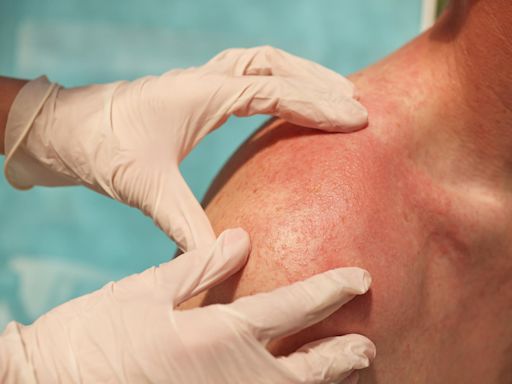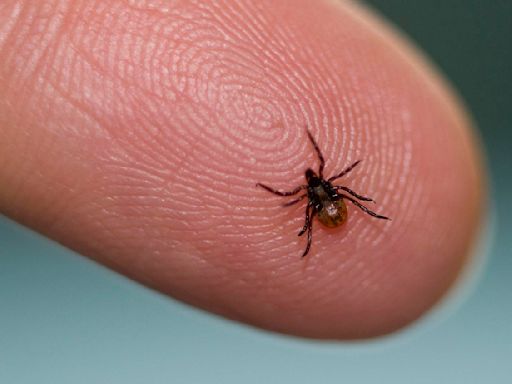Search results
- The Today Show via Yahoo
What does a heat rash look like? How to identify and treat it
Try oatmeal. Azar said that you can make an oatmeal paste at home or put it in the bath and soak. How to prevent heat rash You’re less likely to develop a heat rash if you stay cool and dry, ...
2 days ago
- TODAY via Yahoo
Most tick bites go unnoticed. Here's how to identify and treat them
Ticks can be hard to spot but spread serious diseases. See pictures of what tick bites and rashes look like and get tips from experts on how to identify them.
4 days ago
People also ask
How do you treat heat rash?
How does heat rash heal?
What is a heat rash?
May 31, 2022 · Still, heat rash happens to adults too. Here, experts explain what it is, what it looks like, and, most importantly, how to get rid of heat rash and prevent it from cropping up to begin...
May 6, 2022 · Tips to help your heat rash heal and to be more comfortable include the following: Press a cool cloth on your skin or take a cool shower or bath. It may help to let your skin air-dry. Avoid using oily or greasy moisturizers, cosmetics, sunscreens and other products that can block pores further.
May 2, 2024 · Self-Care Methods. OTC Medications. How Long Does a Heat Rash Last? When to Seek Medical Care. A heat rash (prickly heat or sweat rash) is a painful skin condition that itches and burns because the skin has gotten too hot. It appears as small, pink bumps on light skin tones and white bumps on dark skin tones.
Dec 21, 2023 · How to get rid of heat rash quickly. Heat rash tends to go away on its own in 2 to 3 days. Some home remedies, like the ones described above, can help speed up the process.
- Evan Starkman
- On this page
- Symptoms
- When to see a doctor
- From Mayo Clinic to your inbox
- Causes
- Risk factors
- Complications
- Prevention
•Overview
•Symptoms
•When to see a doctor
•Causes
•Risk factors
•Complications
Sweat glands
Eccrine sweat glands occur over most of the body and open directly onto the skin's surface. Apocrine glands open into the hair follicle, leading to the surface of the skin. Apocrine glands develop in areas with many hair follicles, such as on the scalp, armpits and groin. Eccrine sweat glands are involved in hyperhidrosis, though apocrine glands may play a role as well.
Types of heat rash
The types of heat rash are classified according to how deep the sweat is trapped in the skin. Signs and symptoms for each type vary.
Heat rash usually heals by cooling the skin and avoiding exposure to the heat that caused it. See your health care provider if you or your child has symptoms that last longer than a few days or the rash seems to be getting worse.
Request an appointment
Sign up for free and stay up to date on research advancements, health tips, current health topics, and expertise on managing health. Click here for an email preview.
To provide you with the most relevant and helpful information, and understand which information is beneficial, we may combine your email and website usage information with other information we have about you. If you are a Mayo Clinic patient, this could include protected health information. If we combine this information with your protected health information, we will treat all of that information as protected health information and will only use or disclose that information as set forth in our notice of privacy practices. You may opt-out of email communications at any time by clicking on the unsubscribe link in the e-mail.
Heat rash develops when a duct that leads from a sweat gland to the surface of the skin is blocked or inflamed. This then blocks the opening of the sweat duct on the surface of the skin (sweat pore). Instead of evaporating, sweat is trapped beneath the skin, causing irritation and bumps on the skin.
Factors that increase the risk of heat rash include:
•Being a newborn, as newborns have immature sweat ducts
•Living in a hot, humid climate
•Being physically active
Heat rash usually heals without scarring. People with brown or Black skin are at risk of spots of skin that get lighter or darker in response to inflammatory skin conditions (postinflammatory hypopigmentation or hyperpigmentation). These changes usually go away within weeks or months.
A common complication is infection with bacteria, causing inflamed and itchy pustules.
To help protect yourself or your child from heat rash:
•In hot weather, dress in loose, lightweight clothing that wicks moisture away from the skin. Don't wrap newborns in too many layers.
•In hot weather, limit physical activity. Stay in the shade or in an air-conditioned building. Or use a fan to circulate the air.
•Keep your sleeping area cool and well ventilated.
•Avoid creams and ointments that can block pores.
•Avoid drugs that cause sweating, such as clonidine, beta blockers and opioids.
Apr 25, 2023 · Should heat rash occur, there is a range of home remedies available to treat it. These include cold showers and compresses, as well as a variety of ointments and medications. Last medically...
Apr 11, 2024 · Prevention. Heat rash, also known as eccrine miliaria , sweat rash, and prickly heat, is a skin rash that causes the skin to turn red and feel warm or prickly (stinging). It also causes small red dots in the affected skin area in people with lighter skin tones and darker spots in people with darker skin tones.


